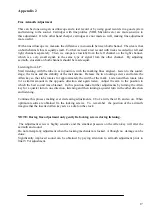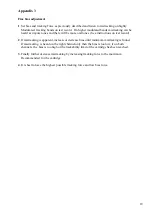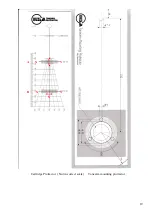
17
Appendix 2
Fine Azimuth Adjustment
This can be done using an oscilloscope and a test record or by using good records in a good system
and listening to the sound. Cartridges with fine profiles (VDH, Microline etc.) are more sensitive to
this adjustment. On the other hand cheaper cartridges are not made so well, making fine adjustment
more useful.
With an oscilloscope we measure the differences in crosstalk between both channel. The idea is that
on both channels this is equally small. For that we need a test record with tracks recorded for left and
right channels separately. Then we compare crosstalk from the left channel on the right channel-
which is a very small signal, to the same type of signal from the other channel. By adjusting
azimuth, crosstalk on both channels should be made equal.
Listening from LP:
Start listening with the tube in zero position, with the marking lines aligned. Listen to the sound-
stage, the focus and the stability of the instruments. Release the two locking screws and rotate the
Allen key so that tube rotates for approximately the width of the mark. Listen and then rotate tube
for a similar amount in the opposite direction and again listen. Adjust the arm to the position in
which the best sound was obtained. In this position make further adjustments by turning the Allen
key for a quarter turn in one direction, listening and then turning a quarter turn in the other direction
and listening.
Continue this process making ever decreasing adjustments, 1/8 of a turn, then 1/l6 and so on. When
optimum results are obtained fix the locking screws. To remember the position of the azimuth,
imagine that the inserted Allen key acts as a dial on the clock.
NOTE: During fine adjustment only gently fix locking screws during listening.
The adjustment screw is highly sensitive and the smallest pressure on the Allen key will alter the
azimuth and sound.
Do not attempt any adjustment when the locking mechanism is locked. Although no damage can be
done.
Significantly improved sound can be obtained by paying attention to azimuth adjustment prior to
final VTA adjustment.



































